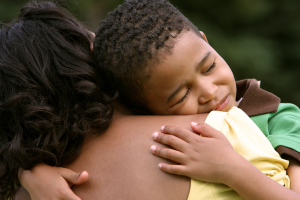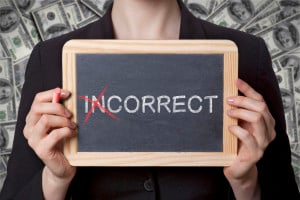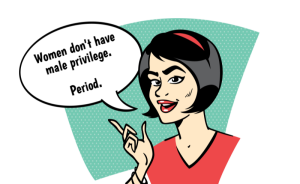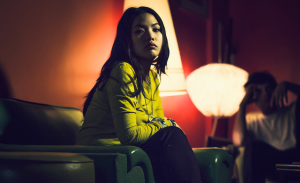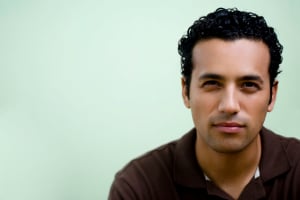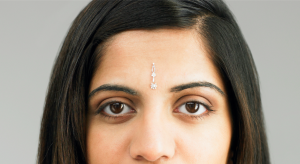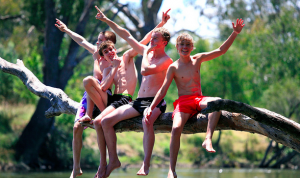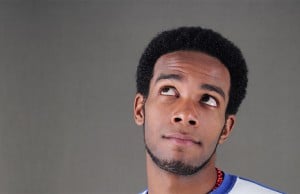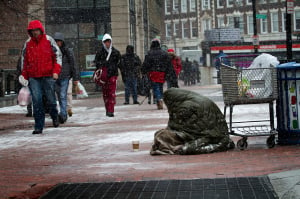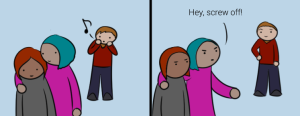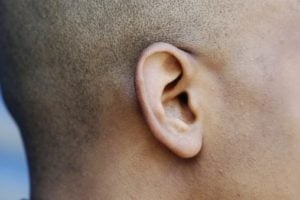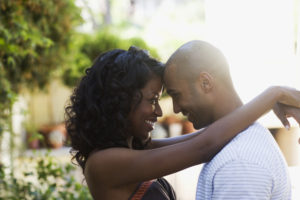
A couple smiling and facing each other while standing outdoors, with one person’s arms hanging from the other’s shoulders.
In a way, there is a safety that comes with being out in public holding a boy’s hand.
I’m seen as straight, feminine, the “right” sort of woman. Nobody harasses me, leering and telling me to kiss him so they can watch. Nobody calls me the d-word or threatens to “turn” me straight. As far as they can tell, I already am.
But the flip side of that safety – conditional as it is – is erasure. In that one glimpse of me with a male partner, eleven years of identifying as queer are erased. Years of struggle, and years of joy, too. In that moment, nobody knows or cares that maybe I’m more into women, maybe most of my partners are women, maybe I can only imagine my life centered around other women.
I’m holding a boy’s hand, so I’m straight.
Being a queer person in a relationship that’s read as straight by others can be painful and invalidating, no matter how healthy and empowering the relationship itself is. Being mislabeled as straight can bring back all our baby-queer insecurities that we thought we were past: being “queer enough,” worrying about taking up space that isn’t “ours” to take up.
I’ve been polyamorous for a few years, which admittedly makes it a lot easier to cope with this because I’m always dating people of various genders. But I remember what it was like when I was in monogamous relationships with men, and even now, I cringe at the thought of bringing one of my male partners – wonderful and progressive as they all are – to a gay bar or queer-related event. It’s not that they’re not welcome there, but that I just know people will look at me and see a straight woman.
When you’ve been with someone of the so-called “opposite” gender for a while, it can start to feel like your queerness doesn’t really matter anymore, or like it isn’t even really there. This is reinforced when people refer to your or your relationship as “straight.”
So how can we maintain and celebrate our queer identities, no matter who we’re with? Here are five suggestions that may help.
1. Consume Media By and About Queer People
Recently I read Dates, an amazing anthology of historical fiction stories featuring diverse queer and trans characters. I’m not at all ashamed to admit that I sobbed openly almost the whole way through the book – not because it was sad, but because it was so positively overwhelming to see people like me and my friends represented in all sorts of cultures and historical periods.
Reading books and watching films and TV shows that feature queer characters can be a powerful way to stay connected to our identities and narratives, as I reminded myself as I cried into that beautiful book.
Even if you’re not dealing with some of those situations yourself right now, engaging with media about queer people can be a way to remind yourself of all the things you have in common with others in the community, regardless of who you’re dating at the moment.
Unfortunately, despite increasing visibility and representation, it’s not always easy to find media that portrays queer characters realistically and three-dimensionally.
In particular, queer female characters often meet some tragic end in order to increase the “acceptability” of those storylines for mainstream audiences. Thankfully, Tumblr users have compiled a list of lesbian romance novels with happy endings.
Autostraddle’s Television, Books, and Film sections are also great places to find more media by and about queer women. And last year, Colorlines did a roundup of books by writers of color that had been nominated for the Lambda Literary Awards, which “celebrate literature for, by, and about the LGBTQIA+ community.”
Media with queer characters is also a great way to learn more about queer experiences that differ from yours due to intersecting identities.
Don’t stick with what you know, or think you know: Read about queer people of different orientations, genders, racial backgrounds, and socioeconomic classes than yours.
Of course, reading or watching stories about queer people isn’t just for education. It’s to feel that connection that you might miss when the people around you erase your queer identity just because of who you’re with.
2. Engage in Activism on Queer Issues
Long before I’d ever dated any women, I was all too aware of the fact that prejudice and discrimination impact me and other queer people no matter who we happen to be dating. If the reality of anti-LGBTQIA+ bias gets you as fired up as it does me, activism can be a powerful way for you to stay connected to your identity.
Does your state or city prohibit discrimination on the basis of sexual orientation and gender identity? Does your university offer courses on LGBTQIA+ history and queer theory? Do homeless LGBTQIA+ youth in your area have access to resources that affirm their gender and sexuality and keep them safe from queerphobic/transphobic violence?
Do your local public schools include accurate, non-stigmatizing information about LGBTQIA+ identities in their sex education curricula? Does your local LGBTQIA+ community center actively include and welcome people who are bi, pan, trans, asexual, or otherwise not gay or lesbian?
The answer to at least one of those questions is probably no, which means that there’s plenty to be done.
Although we’ve achieved marriage equality at the national level, there are plenty of other issues that impact that LGBTQIA+ community – like nonconsensual surgery on intersex infants and violence against trans women of color – that marriage doesn’t solve, and that urgently need to be addressed.
If it’s something you feel safe doing and are able to do, engaging in LGBTQIA+ activism can help you stay connected to your own identity while also giving back to the queer community.
When you’re in a relationship that’s read as straight by others, many people believe that you’re no longer impacted by homophobia and biphobia – which is bullshit.
But while that’s not true, it’s easy to start believing it when you hear it often enough. And activism can be a way to remind yourself of everything we still need to fight for.
3. Spend Time in Queer-Centered Spaces
Straight people can be wonderful friends, allies, and partners, but sometimes it’s important to take some time to connect with other queers.
Although most queer spaces do welcome straight allies, consider leaving your partner at home if they’re straight, even just once. You might find that you have an entirely different experience.
Queer-centered spaces allow us to reconnect with people who share our identities and open up in ways that we aren’t always able to do if straight people are present, or able to center themselves.
In my experience, even the most supportive straight friend or partner has occasionally let slip a “But surely it isn’t that bad” or a “But you know not all of us are like that, right?”
In queer-centered spaces, we don’t have to worry about how our frustrations and fears will be perceived by straight people.
If you don’t live in a large city, it can be hard to find these spaces in person. Remember that online groups and communities totally count. The Internet is “real life” too, and it can be a valuable lifeline for queer people living in isolated or very conservative areas.
Sadly, some queer-centered spaces are still unwelcoming or unsafe for bisexual, pansexual, and other polysexual people. Biphobia is real, and it hurts. You never have to participate in a queer-centered space that is hostile to your identity, and connecting with other polysexual folks can help you find spaces that do better.
Everyone deserves to be able to access spaces that affirm who they are, and for queer folks in relationships read as straight, these spaces can be a valuable way to re-center their queer identities.
4. Stay Connected to Your Queer Friends
Because of the way romantic relationships are centered in our culture, many people let their friendships fall by the wayside while they’re dating someone seriously, even if they love and value their friends and never intended to drift away from them.
Although this dynamic impacts people of all orientations, it can be especially harmful to a queer person who’s in a relationship that’s read as straight, especially if their partner is straight.
They may end up spending more time with that partner’s (probably also straight) friends than their own, perhaps out of a desire to avoid seeming “heteronormative” to their queer friends. As a result, it’s even harder for them to stay connected to their own identity.
A lot of us have anxieties about being “queer enough” in our social circles, but in reality, true friends love and support you regardless of your partner’s gender.
Make sure to make time for your queer friends (and, really, all your friends) even when you’re in a serious romantic relationship. They’ll remind you of a part of your identity that your partner might not, and they’ll be the ones feeding you ice cream and/or alcohol if the relationship ends one day.
5. Talk to Your Partner About It – Especially If They’re Straight
A lot of us shy away from talking to our partners about things like this because we worry that they’ll feel guilty for “stealing” us from the queer community, or that they won’t understand.
But a key part of staying connected to your queer identity is to let your partner know how the relationship is impacting you, positively and negatively.
Having others continually erase your identity and label your relationship (and, by extension, you) as straight can be painful, alienating, and confusing. Let your partner know what that’s like for you. Let them support you.
In particular, tell your partner if you think there’s anything they can do to help you maintain your identity. This could include correcting friends and family who misidentify you or your relationship as “straight,” encouraging you to attend queer-related events, and knowing when to step back so you can engage with other queer people and communities.
***
Unfortunately, over the course of your journey to affirm and celebrate your identity, you may come across people – including other queer people – who insist that your current relationship structure means you’re straight now, or that your queerness is somehow no longer relevant.
If this happens to you, I’m sorry. You don’t deserve that kind of invalidation, especially not from other queer people.
As Kayla Rosen writes at Bitopia, “Queerness is about how you feel and identify, not the stats of whom you’ve dated or fucked.” Even if you’ve never been in a relationship that others would categorize as non-straight, you can still be queer!
While you have the right to publicly claim a queer identity and participate in queer spaces, know that you never have to stay in a space where people are invalidating your identity (unless, of course, you’d rather stay and fight them on it).
While our community is still working on recognizing the complexities of identity and attraction, there are plenty of people out there who are more interested in welcoming and supporting you than in being queerer-than-thou.
My hope is that sometime within our lifetimes, we’ll be able to build a culture in which different queer identities are visible enough that people stop assuming you’re straight just because of who they see you holding hands with.
Until then, maintaining and celebrating your queer identity while you’re in a relationship that’s read as straight can be challenging. But you’re not alone, and you have allies – straight and queer – in this journey.
[do_widget id=’text-101′]
Miri Mogilevsky is a Contributing Writer for Everyday Feminism and a recently graduated with a Masters in Social Work and is starting a career as a counselor in Columbus, Ohio. She loves reading, writing, and learning about psychology, social justice, and sexuality, and is working on her cat photography skills. Miri writes a blog called Brute Reason, rants on Tumblr, and occasionally even tweets @sondosia.
Search our 3000+ articles!
Read our articles about:
Our online racial justice training
Used by hundreds of universities, non-profits, and businesses.
Click to learn more
Most Read Articles
- « Previous
- 1
- …
- 30
- 31
- 32





